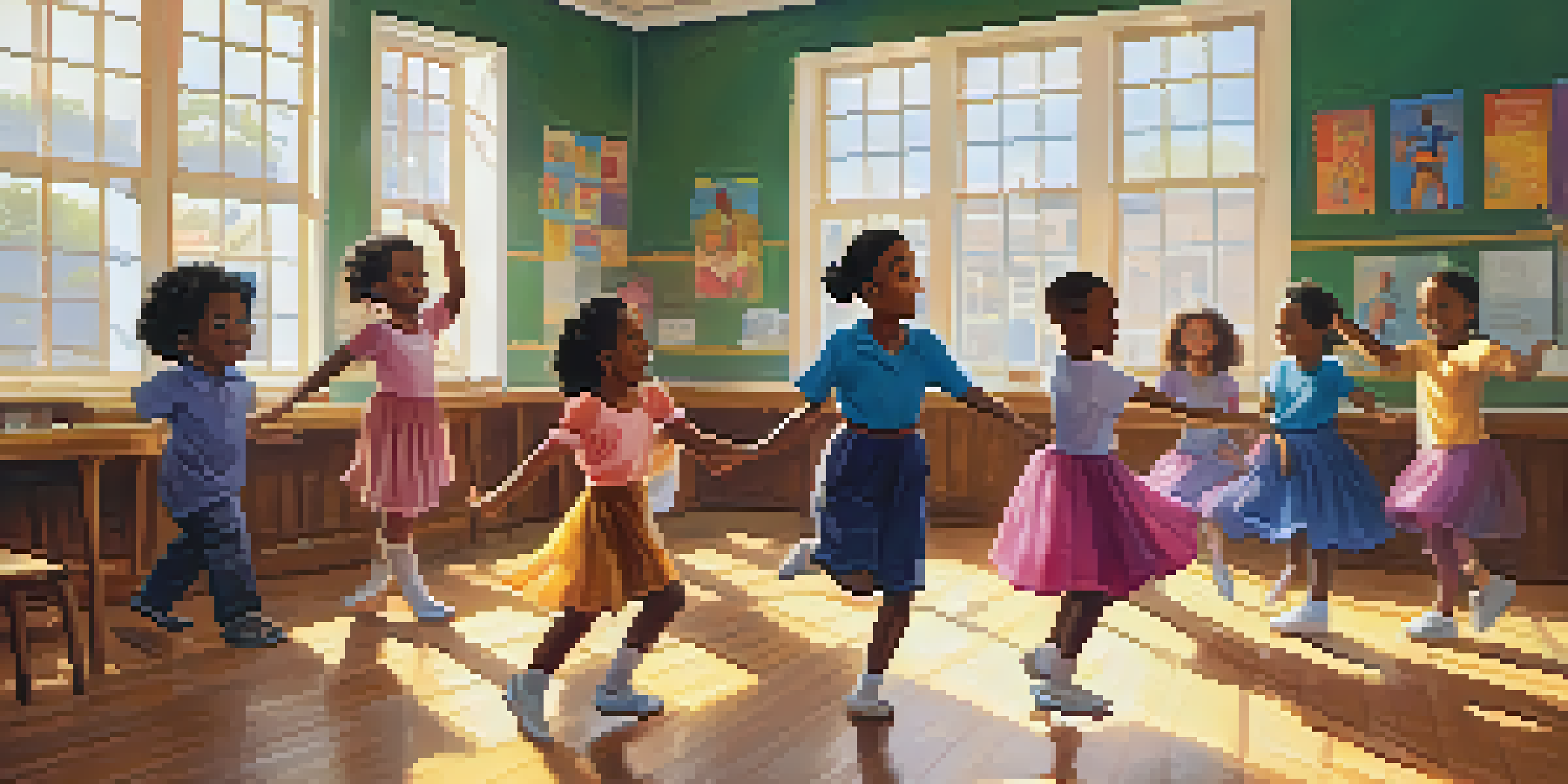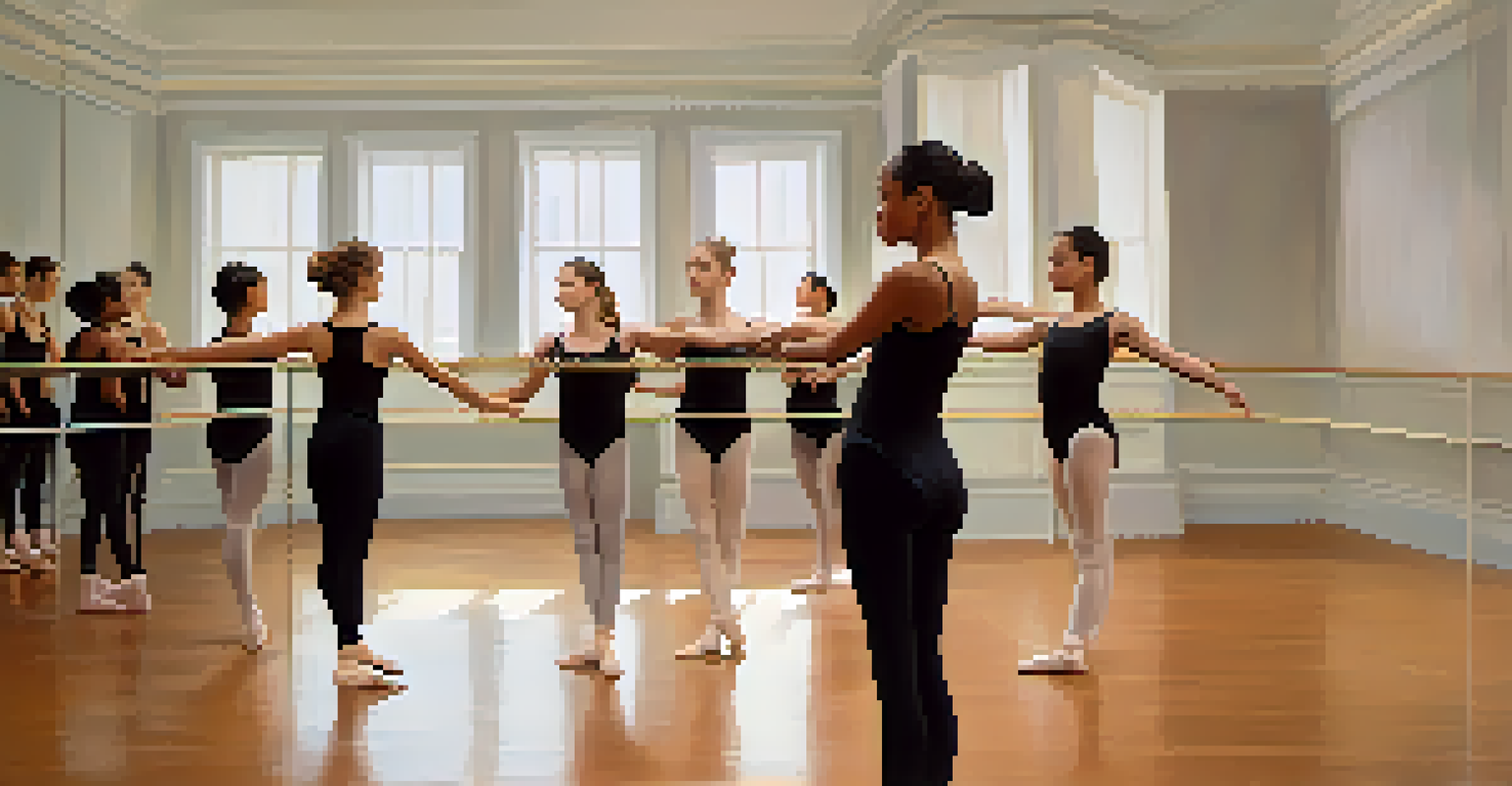Integrating Dance into School Curricula: A Comprehensive Guide

Understanding the Importance of Dance in Education
Integrating dance into school curricula is not just about movement; it fosters creativity, discipline, and teamwork among students. Dance allows children to express themselves, which is crucial for emotional development. Schools that include dance also see improvements in students' academic performance, as physical activity enhances cognitive function.
Dance is the hidden language of the soul.
Moreover, dance promotes inclusivity, as it can be adapted to various abilities and cultures. Students learn about diversity through different dance styles, which can deepen their understanding of global cultures. This exposure helps cultivate empathy and respect for others, essential skills in today's interconnected world.
Ultimately, the inclusion of dance in education is about nurturing well-rounded individuals. It's a powerful tool that can boost self-esteem and confidence while providing a fun outlet for stress relief. Schools should view dance not just as an art form, but as an integral part of a holistic educational experience.
Identifying Goals for Dance Integration
Before diving into integration, schools must clearly define their goals for including dance in their curricula. Are the aims to improve physical fitness, enhance creativity, or foster social skills? Establishing specific objectives will guide the development of a structured program that meets the needs of the students.

Involving teachers, parents, and students in this goal-setting process can provide diverse perspectives and ensure buy-in from the entire school community. For instance, a survey could offer insights into what styles of dance students are most interested in, making the program more engaging. This collaborative approach not only builds excitement but also reinforces a sense of ownership over the dance initiative.
Dance Boosts Creativity and Learning
Integrating dance into education enhances creativity, discipline, and academic performance while promoting emotional development.
Once goals are established, it's essential to create measurable outcomes to track progress. Whether that's improved participation in dance classes or increased collaboration in group projects, having benchmarks in place will help educators assess the program's effectiveness over time. This reflective practice can lead to continuous improvement and adaptation of the dance curriculum.
Creating a Dance Curriculum Framework
A well-structured dance curriculum is crucial for effective integration into schools. This framework should outline the various dance styles to be taught, ranging from ballet to hip-hop, and align them with educational standards. Each level of the curriculum can build on the previous one, encouraging students to develop their skills progressively.
Education is not just about filling a pail, but the lighting of a fire.
It's also important to include cross-curricular connections. For example, dance can be linked to subjects like history through the exploration of traditional dances from different eras or cultures. By integrating dance with academics, students can see the relevance of movement in a broader context, enhancing their overall learning experience.
Additionally, providing resources for teachers is vital. Professional development opportunities, online workshops, or partnerships with local dance studios can equip educators with the necessary skills to teach dance effectively. This support not only empowers teachers but also ensures that students receive high-quality instruction.
Training Teachers for Dance Instruction
One of the key challenges in integrating dance into school curricula is ensuring that teachers are adequately trained. Many educators may not have a dance background, which can lead to apprehension about teaching dance. Offering specialized training sessions can boost their confidence and equip them with the skills needed to lead dance classes.
Collaboration with local dance organizations can be beneficial here. These organizations often have experienced instructors who can provide workshops and resources tailored to teachers' needs. By fostering partnerships, schools can create a supportive network that enhances the quality of dance education.
Goals Guide Dance Curriculum Design
Clearly defined goals for dance integration help shape structured programs that meet the diverse needs of students.
Moreover, mentorship programs can be established, pairing experienced dance teachers with those new to the field. This ongoing support encourages a culture of learning and growth among educators, ultimately benefiting the students they teach. Investing in teacher training is a crucial step toward a successful dance integration initiative.
Engaging Students Through Interactive Dance Activities
To keep students engaged, incorporating interactive dance activities is essential. This could involve creative movement sessions where students explore their own interpretations of music or themes. By allowing them to express themselves freely, students are more likely to develop a love for dance and look forward to their classes.
Group choreography projects can also enhance teamwork skills while making dance more enjoyable. Working together to create a performance fosters collaboration and communication, key skills that will serve students well beyond the dance floor. These projects can culminate in school-wide showcases, giving students a platform to share their hard work.
In addition to traditional dance styles, consider including elements like improvisation or even dance technology. Using apps or video editing tools can engage tech-savvy students and introduce them to the creative aspects of dance in the digital age. Embracing innovation keeps the curriculum fresh and exciting.
Assessing the Impact of Dance Programs
Regular assessment of dance programs is crucial to understanding their impact on students' development. Schools should implement both qualitative and quantitative measures to evaluate success. Surveys and feedback forms can provide insights into students' experiences, while performance assessments can gauge skill development.
Moreover, tracking academic performance and social behavior can help educators see the broader effects of dance. For example, schools might notice improved attendance or engagement in other subjects as students become more involved in dance. These connections can help justify the continued integration of dance into the curriculum.
Sustainability Ensures Dance Program Longevity
Building a sustainable dance program relies on community support, diversified funding, and fostering a culture of appreciation for the arts.
Sharing these findings with the school community can also build support for the program. Highlighting success stories and celebrating student achievements can inspire others to participate in dance activities. By showcasing the positive outcomes, schools can foster a culture that values and embraces the arts.
Building a Sustainable Dance Program
To ensure the longevity of a dance program, schools must focus on sustainability. This involves securing funding through grants, community partnerships, or fundraising events. By diversifying funding sources, schools can maintain their dance initiatives even when budgets are tight.
Community involvement is also key to sustainability. Engaging parents and local organizations can create a support network that enhances the program's resources and visibility. For instance, hosting dance events or workshops can draw in community members and raise awareness about the importance of dance education.

Lastly, fostering a culture of appreciation for the arts within the school can help sustain interest and participation in dance. Celebrating achievements and encouraging students to pursue dance outside of school can create a vibrant dance community that thrives on passion and commitment. With the right support, a dance program can flourish for years to come.